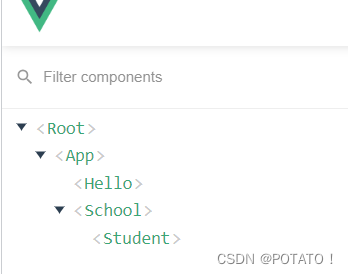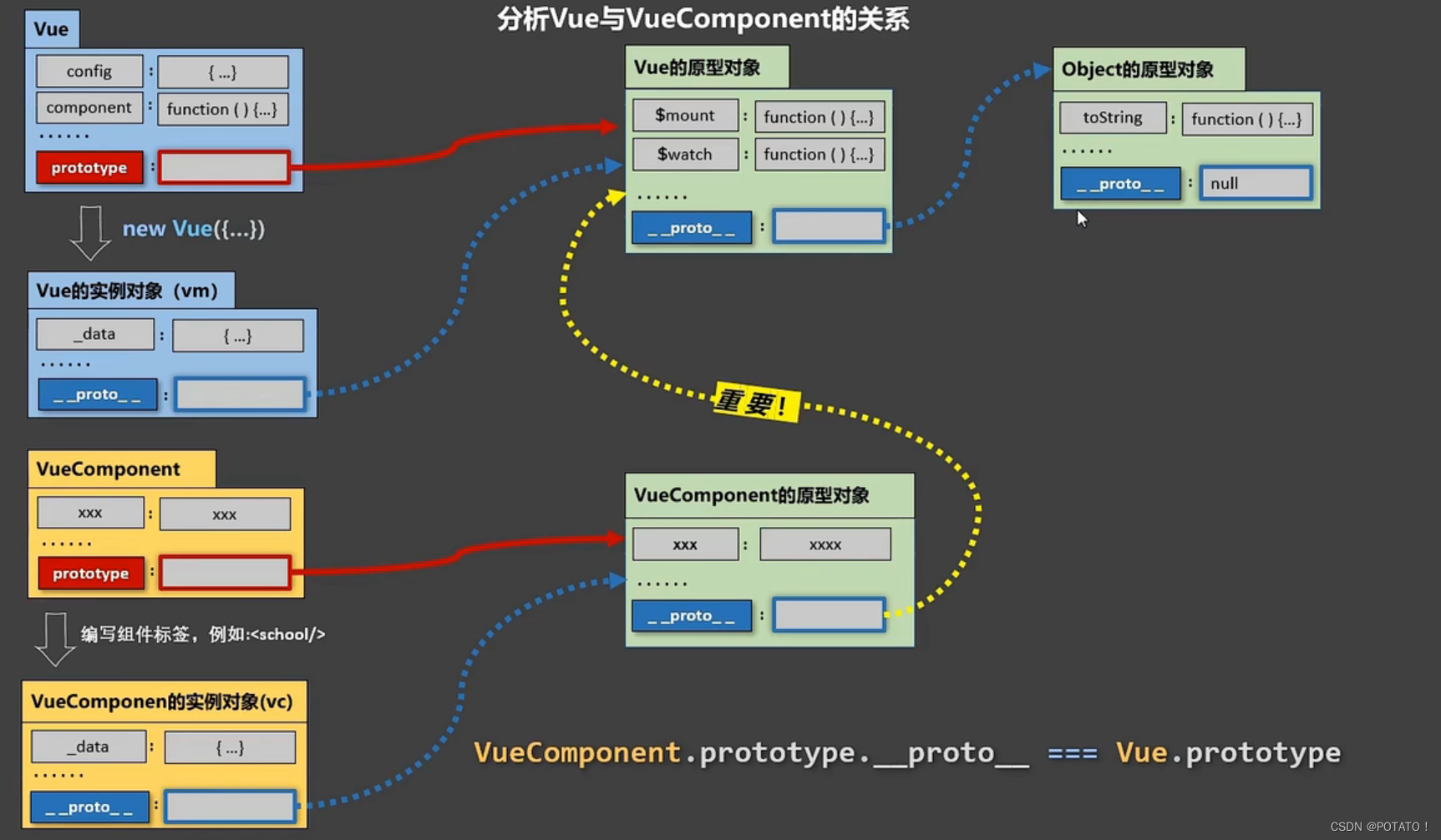杭州做网站国家市场监督管理总局官网
🥔:功不唐捐
更多Vue知识请点击——Vue.js
VUE-Day5
- 组件与使用组件的三大步
- 1、定义组件(创建组件)
- 2、注册组件
- ①局部注册
- ②全局注册
- 3、使用组件
- 小案例:
- 使用组件的一些注意点
- 1.关于组件名
- 2.关于组件标签
- 3.一个简写方式
- 组件的嵌套
- VueComponent构造函数
- 一个重要的内置关系
- 单文件组件
组件与使用组件的三大步
组件:实现应用中局部功能代码和资源的集合。
传统方式编写缺点:
- 依赖关系混乱
- 代码复用率不高
使用组件编写优点:
- 依赖关系明晰
- 复用率较高
- 提高运行效率
非单文件组件与单文件组件:
-
非单文件组件:一个文件中包含n个组件
-
单文件组件:一个文件中只包含1个组件
如何使用组件,三大步:
1、定义组件(创建组件)
2、注册组件
3、使用组件(写组件标签)
1、定义组件(创建组件)
使用Vue.extend(options)创建,其中options和new Vue(options)时传入的那个options几乎一样,但也有点区别
区别如下:
(1)el不要写,为什么?
最终所有的组件都要经过一个vm的管理,由vm中的el决定服务哪个容器。备注:使用template可以配置组件结构。
(2)data必须写成函数,为什么?
避免组件被复用时,数据存在引用关系,比如我父组件要多次复用一个子组件,那如果其中一个子组件做了修改数据操作,其他复用的地方数据也会被修改。如果某个组件中的data写成对象形式,且组件内有对数据的操作,那么该组件在多次复用时,每次点击某一个按钮,其他组件实例的数据都会改变,这样是不行的。
2、注册组件
①局部注册
创建vmnew Vue的时候传入components选项
<!-- 准备一个容器 --><div id="root"><xuexiao></xuexiao><hr><xuesheng></xuesheng></div><script>//第一步:创建school组件const school = Vue.extend({name: 'dj', //可以使用name配置项指定组件在开发者工具中呈现的名字(只是开发者工具里用的名字)。// el: '#hello' el不能写template: `<div><h2>学校名字{{schoolName}}</h2><h2>学校地址{{address}}</h2></div>`,data() {return {schoolName: 'web',address: '广州',}}})//第一步:创建student组件const student = Vue.extend({template: `<div><h2>学生名字{{studentName}}</h2><h2>学生年龄{{age}}</h2><button @click="add">点击年龄+1</button></div>`,data() {return {studentName: 'potato',age: 18}},methods: {add() {this.age++;}},})//创建一个vm带领小弟接管root容器const vm = new Vue({el: '#root',// 第二步:注册组件(局部注册)components: {//组件名:组件//这里最好写成school:school,简写为schoolxuexiao: school,//这里最好写成student:student,简写为studentxuesheng: student}})</script>
②全局注册
靠Vue.component('组件名',组件)
<!-- 准备一个容器 --><div id="root"><sayhello></sayhello></div><!-- 准备第二个容器 --><div id="root2"><sayhello></sayhello></div><script>//第一步:创建组件const hello = Vue.extend({template: `<div><h2>{{msg}}</h2></div>`,data() {return {msg: 'hello world'}}})//第二步:全局注册组件Vue.component('sayhello', hello);//创建第一个vm接管rootconst vm = new Vue({el: '#root'})//创建第二个vm接管root2new Vue({el: '#root2'})</script>
3、使用组件
直接写组件名的标签就可以,一般我们定义组件时,组件名和定义的名字最好一样,这样就可以简写。
<!-- 准备一个容器 --><div id="root"><xuexiao></xuexiao><xuesheng></xuesheng></div>
小案例:
<!DOCTYPE html>
<html lang="en"><head><meta charset="UTF-8" /><meta name="viewport" content="width=device-width, initial-scale=1.0" /><title>组件初识</title><script src="../js/vue.js"></script></head><body><div id="root"><!-- 编写组件标签 --><school></school><hr /><student></student></div><script>// 创建school组件const school = Vue.extend({template: `<div><h2>学校名称:{{schoolName}}</h2><h2>学校地址:{{address}}</h2></div>`,data() {return {schoolName: "新东方",address: "山东",};},});// 创建student组件const student = Vue.extend({template: `<div><h2>学生姓名:{{studentName}}</h2><h2>学生年龄:{{age}}</h2></div>`,data() {return {studentName: "张三",age: 18,};},});// 创建vmnew Vue({el: "#root",// 注册组件components: {school,// xuexiao: school,student,// xuesheng: student,},});</script></body>
</html>
使用组件的一些注意点
1.关于组件名
一个单词组成:
第一种写法(首字母小写):school
第二种写法(首字母大写):School
多个单词组成:
第一种写法(kebab-case命名):‘my-school’
第二种写法(CamelCase命名):MySchool (需要Vue脚手架支持)
备注:
(1).组件名尽可能回避HTML中已有的元素名称,例如:h2、H2都不行。
(2).可以使用name配置项指定组件在开发者工具中呈现的名字(不影响注册的名字)。
2.关于组件标签
第一种写法:<school></school>
第二种写法:<school/>
备注:不用使用脚手架时,<school/>会导致后续组件不能渲染。
3.一个简写方式
const school = Vue.extend(options) 可简写为:const school = options
组件的嵌套
这里要注意,vm里要写el,其他都不写。vm里的template可以不用写根节点,因为vm里的东西是放到容器里的,而组件的template要用根节点包起来(如div)。注意创建组件时,要先创建子组件才能创建父组件。
案例(仔细看看代码,观察如何实现嵌套):
- 嵌套图示:

- 代码:
<!DOCTYPE html>
<html lang="en"><head><meta charset="UTF-8" /><meta name="viewport" content="width=device-width, initial-scale=1.0" /><title>组件的嵌套</title><script src="../js/vue.js"></script></head><body><div id="root"><!-- 编写组件标签 --><!-- <app></app> 可以不在这写,可以写在new Vue的template里--></div><script>// 创建student组件const student = Vue.extend({template: `<div><h2>学生姓名:{{studentName}}</h2><h2>学生年龄:{{age}}</h2></div>`,data() {return {studentName: "张三",age: 18,};},});// 创建school组件const school = Vue.extend({template: `<div><h2>学校名称:{{schoolName}}</h2><h2>学校地址:{{address}}</h2><student></student></div>`,data() {return {schoolName: "新东方",address: "山东",};},components: {student,},});//创建hello组件const hello = Vue.extend({template: `<h1>{{msg}}</h1>`,data() {return {msg: "欢迎大家一起学习Vue",};},});//创建app组件const app = Vue.extend({template: `<div><hello></hello><school></school></div>`,components: {school,hello,},});// 创建vmnew Vue({template: `<app></app>`,el: "#root",// 注册组件(局部)components: {app,},});</script></body>
</html>
VueComponent构造函数
组件是一个Vue.extend生成的构造函数,当组件写到页面上时,Vue开始解析,同时自动new了一下,这才创建了组件的实例对象
1、什么是VueComponent?
-
school组件本质是一个名为VueComponent的构造函数,且不是程序员定义的,是Vue.extend生成的。
-
我们只需要写
<school/>或<school></school>,Vue解析时会帮我们创建school组件的实例对象,即Vue帮我们执行的:new VueComponent(options)。 -
特别注意:每次调用Vue.extend,返回的都是一个全新的VueComponent构造函数,而不是返回VueComponent的实例(这个地方不要陷入误区),只有当Vue解析组件时,才会返回所对应组件(如school)的VueComponent的实例对象
2、VueComponent中的this指向
VueComponent的实例对象,以后简称vc(也可称之为:组件实例对象)。Vue的实例对象,以后简称vm
- 组件配置中:data函数、methods中的函数、watch中的函数、computed中的函数。它们的this均是【VueComponent实例对象】。
- new Vue(options)配置中:data函数、methods中的函数、watch中的函数、computed中的函数 它们的this均是
【Vue实例对象】。
一个重要的内置关系
这里用到了原型的知识,可以倒回去复习一下点击此处
1、一个重要的内置关系:VueComponent.prototype.__proto__ === Vue.prototype
2、为什么要有这个关系:让组件实例对象(vc)可以访问到 Vue原型上的属性、方法。

单文件组件
为了确保vue开发者工具里的名称和组件名称一致,组件命名最好采取首字母大写形式(如下面案例:School.vue,Student.vue,App.vue)
-
School.vue
// 组件的结构 <template><div class="demo"><h2>学校名称:{{ name }}</h2><h2>学校地址:{{ address }}</h2><button @click="showName">点我提示学校名称</button></div> </template>// 组件交互相关的代码(数据、方法等) <script> // 也可以写export default Vue.extend({}) export default {name: "School",data() {return {name: "新东方",address: "山东",};},methods: {showName() {alert(this.schoolName);},}, }; </script>// 组件的样式 <style> .demo {background-color: pink; } </style> -
Student.vue
// 组件的结构 <template><div class="demo"><h2>学生姓名:{{ name }}</h2><h2>学生年龄:{{ age }}</h2></div> </template>// 组件交互相关的代码(数据、方法等) <script> // 也可以写export default Vue.extend({}) export default {name: "School",data() {return {name: "张三",age: 18,};}, }; </script> -
App.vue
<template><div><School></School><Student></Student></div> </template><script> import School from "./School"; import Student from "./Student";export default {name: "App",components: {School,Student,}, }; </script> -
main.js
import App from "./App";new Vue({el: "#root",template: `<App></App>`,components: { App }, }); -
index.html
<!DOCTYPE html> <html lang="en"><head><meta charset="UTF-8" /><meta name="viewport" content="width=device-width, initial-scale=1.0" /><title>单文件组件的语法</title></head><body><div id="root"></div><script src="../../js/vue.js"></script><script src="./main.js"></script></body> </html>
